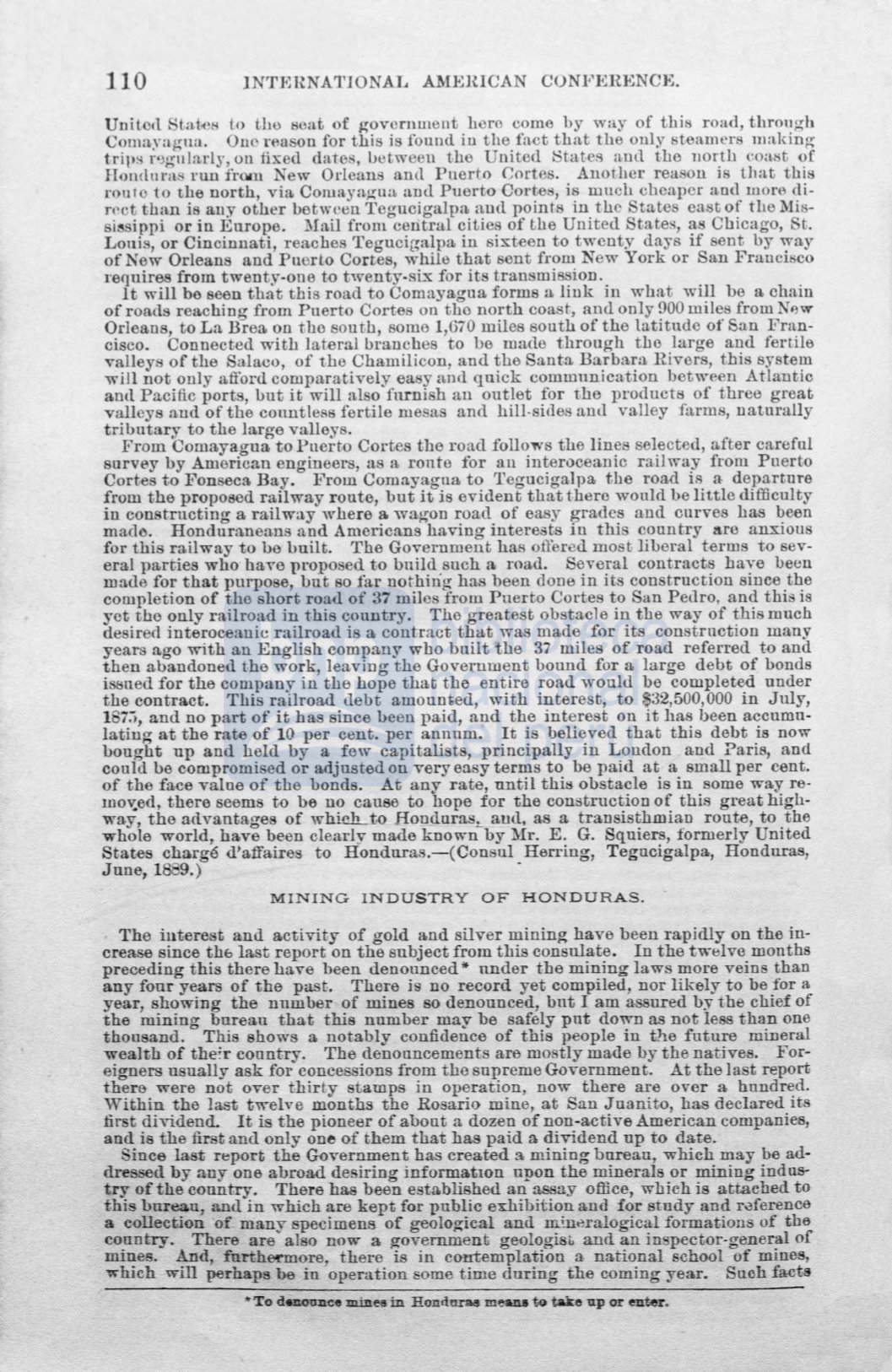

110
INTERNATIONAL AMERICAN CONFERENCE.
Unitofl
'tates io tbe soat of govornment bero come by way of tbis road, tbrongh
Coma,,·
t.~
gua. Ono reason for this is found in the fact that the ouly Bteamers nmking
trips r'.}gnl::l.rly, ou fixed dates, l>etween the United States anü the north
eoa~;¡t
of
Hondnra run from New Orleans and Puerto C:ortes. Another rea ou is that tbis
routo to the north, via Coruayagua and Puerto Cortes, is mnch cbeapcr and more di–
n'ct tban is any other betwcen Tegucigalpa and points in thc States east of the Mis–
sil!sippi or in Europe. Mail from central cities of tbe United States, as Cbicago, St.
Louis, or Cíncinnati, reaches Tegucigalpa in sixteen
to
twenty days if sent by way
of New Orleans and Puerto Cortes, while that sent from New York or San Francisco
requires from twenty-oue
to
twenty-six for its transmission.
lt
will be seen that this road to Comayagua forms a link in wbat will be a chain
of roacls reaching from Puerto Cortes on tbe north coast, and only 900 miles from
N~w
Orleans, toLa Brea on the soutb, sorne 1,670 miles soutb of the latitude of San Fran–
cisco. Connected with la
teral brancbes to be made tbrongh the large and fertile
valley of the Salaco, of t.he Cbamilicon, and tbe Santa Barbara. Rivers, this system
will not only afford comparatively ea y aucl quick communication between Atlantic
and Pacific ports, bnt it will also furnish an outlet for the products of three great
vallcys and of tbe countless fertile mesas and hill-sides aml valley farms, natnrally
tributary to the large valleys.
From Comayagua to Puerto Cortes the road follows the linea selected, after careful
surve.y by American engineers, as a ronte for au interoceanic railway from Puerto
Cortes to Fonseca Bay. From Comayagua to Tegucigalpa tbe road is a departure
from the proposed railway route, but it is evident thatthere would be little difficulty
in constructing a railway where a wagon road of easy grades and curves has been
made. Honduraneans and Americana having interests in this country a,re anxious
for this railway to be lmilt. Tbe Government has ofiercd most liberal terms to sev–
era} parties who·bave proposed to bnild such a road. Several contracta bave been
made for that purpose, but so far nothirig has been done in its constrnction since tbe
completion of the short road of 37 miles from Puerto Cortes to San Pedro, and this is
yet the only railroad in tbis country. The greatest obstacle in the way of this much
desirerl interoceanic railroad is a contract that was made for its construction many
years ago with an English company who built the 37 miles of road referred to and
then abandoned the work, leaving the Govemment bonnd for a large debt of bonds
issued for the company in the hope that tbe entire road would be comp1eted nnder
the contract. This railroad debt amounted, with interest, to $32,500,000 in July,
1
7:í, and no part of
it
has since been paid, and the interest on it has l.>een accumu–
latíng at the rate of
10
per cent. per annnm.
It
is believed that this debt is now
bougbt up and held by a few capitalista, principally in Loudon and Paris, and
could be compromised or adjnsted on very easy terma to be paid at a small per cent.
of tbe face valne of tbe bonds. At any rate, nntil tbis obstacle is in sorne way re–
mo~ed,
there seems to be no canse to hope for the construction of tbis great higb–
way, the aclvantage of whiclLto Hon_du!'aSL aud, as a transisthmian route,
to
the
whole world, have been clearly made known by Mr. E. G. Squiers, formerly United
States chargé d'affaires to Honduras.-(Con ul Herring, Tegucigalpa, Honduras,
June,
18
9.)
MINING INDUSTRY OF HONDURAS.
The iuterest and activity of gold and silver miníng have been rapidly on the in–
crease since tbb last report on the subject from this consnlate.
In the twelve montbs
precedíng this there ha>e been denounced
*
nnder tbe mining laws more veins than
any fonr years of tbe past. There is no record yet compiled, nor likely to be for a
year, showing the nnmber of mines so denounced, but
1
am assured by the chlef of
the mining bureau that this number may be safely put down as not less than one
thou and. Tbis sbows a notably confidence of this people in t..l}e future mineral
wealtb of the!r country. Tbe denonncements are mostly made by tbe natives. For–
eigners usually ask for concessions from the snpreme Government. At the last report
there were not over thirty stamps in operation, now there are over a hundred.
Within the last twelve ruonths the Rosario mine, at San Jnanito, has declared its
first dividend.
lt is the pioneer of about a dozen of non-active American companies,
and is the ñr
t
and only one of them that has paid a dividend up to date.
Since last report the Government has created a mining bureau, which may be ad–
dressed by any one abroad desiring informat10n upon the minera1s or mining indus–
try
ofthe co
nntry. Tbere has been e tablished an assay office, which is attached to
this bnrean,
a.ndin which are kept for public exhibition and for stndy and r.3ference
a
eollection of many pecimens of geo1ogical and
mi.n~ralogical
formations of tbe
co_untry. There are also now a government geologist andan inspector-general of
m~e.s. ~d, furth~more,
there is in contempla.tion a national school of mines,
w-hich will perhaps be in operation sorne time dnring the coming year. Snob facts
*
To denotmee
min~s
in
Honfiuras
meana
to
take up or enter.
















